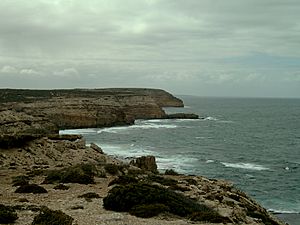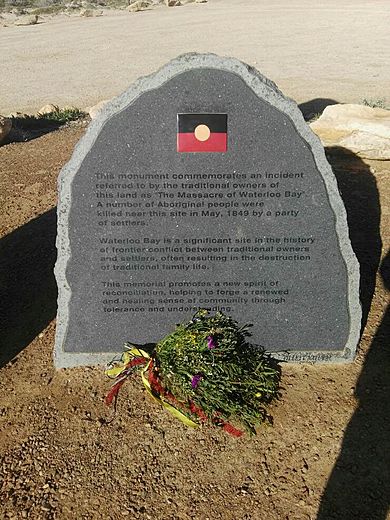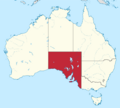Waterloo Bay massacre facts for kids
Quick facts for kids Waterloo Bay massacre |
|
|---|---|
| Part of Australian frontier wars | |

The cliffs of Waterloo Bay
|
|
| Location | Elliston, South Australia |
| Coordinates | 33°39′S 134°53′E / 33.65°S 134.88°E |
| Date | May 1849 |
| Target | Aboriginal Australians |
| Deaths | See Authenticity and interpretations section |
| Assailants | European settlers |
The Waterloo Bay massacre, also known as the Elliston massacre, was a fight between European settlers and Aboriginal people. It happened on the cliffs of Waterloo Bay near Elliston, South Australia, in May 1849. This event was part of the Australian frontier wars, which were conflicts between settlers and Aboriginal people. Many historians now believe that many Aboriginal people died during this clash.
Official records from that time say only a few Aboriginal people died. However, stories about up to 260 Aboriginal people being killed at the cliffs have been told since at least 1880. Aboriginal people from the west coast of South Australia have passed down these stories through their families.
In the 1920s and 1930s, some historians looked at old records. They found no direct proof of a large-scale massacre. They thought the stories might have grown bigger over time. More recently, another historian suggested that the stories are based on real events. They believe some kind of punishment happened at the cliffs, but the details might have been exaggerated.
In the 1970s, people tried to build a memorial for the Aboriginal people who died. However, the local council asked for proof of the massacre first. A memorial for the European settlers who died before this event already existed. In 2017, the Elliston District Council put up a new memorial to remember what happened. In recent years, writers have said that this event has become a "narrative battleground." This means it's a place where written history and Aboriginal oral history clash. In May 2018, the Elliston District Council won an award for their work in remembering the massacre.
Contents
Early Conflicts in South Australia
In March 1839, European settlers arrived from Adelaide, the capital of South Australia. They came to set up Port Lincoln on the east coast of the Eyre Peninsula. Over the next few years, there were many fights between settlers and Aboriginal people. This happened as settlers moved out to create farms around Port Lincoln. These fights were part of the Australian frontier wars.
In 1842, soldiers came from Adelaide to protect the settlers. But Port Lincoln was far away, and the local government leader had limited power. This meant that laws were hard to enforce, especially for Aboriginal people. Aboriginal people were supposed to be treated like British citizens, just like the settlers.
Settlers often used different ways to deal with Aboriginal resistance. They wanted to stop Aboriginal people from interfering with their animals and property. At first, they used threats. But soon, these actions became more violent. Sometimes, these actions led to clashes.
Violence by settlers against Aboriginal people was often not reported. It became even more secret after a settler was put to death in 1847 for killing an Aboriginal man. This was the only time such a sentence happened in South Australia's early history. Historians have called this frontier violence a secret war between settlers and Aboriginal people.
Events Leading to the Massacre
Between June 1848 and May 1849, several incidents happened in the Elliston area. This area is about 169 kilometers northwest of Port Lincoln. Nauo, Kokatha, and Wirangu Aboriginal groups lived here.
In the first incident, on June 23, 1848, a man named John Hamp was killed by Aboriginal people. He worked on a sheep farm called Stony Point. In August, at least one Aboriginal person was shot by the farm's overseer. This happened because the Aboriginal person was accused of stealing a shirt.
In May 1849, five Aboriginal people died. They were two adults, two boys, and a baby. They ate poisoned flour that an Aboriginal man had taken from a farm near Yeelanna. The man who owned the flour was arrested but later released. He then left for the United States.
The police chief thought this poisoning might have led to two revenge killings of settlers later that month. On May 3, James Rigby Beevor was killed at his hut. Four days later, Annie Easton was killed on a nearby farm.
What the Records Say
Official records state that on May 27, 1849, goods were taken from a hut on Thomas Cooper Horn's farm. A worker and a shepherd were threatened by Aboriginal people. Horn and his men chased the group. When they caught up, shots were fired and spears were thrown.
The Aboriginal group split up. Horn and his men followed one group to the Waterloo Bay cliffs. The group tried to climb down the cliffs to escape. Horn and his men started shooting. Two Aboriginal people were killed, and one was badly hurt and later died. Several others were captured.
The local government leader and the police inspector from Port Lincoln wrote detailed reports. Neither report mentioned many deaths. One report said only two Aboriginal people were killed.
In September, some Aboriginal men were taken to Adelaide for trial. Two were found guilty of Beevor's murder. They were taken back to the Elliston area and put to death outside his hut. Three others were accused of Easton's murder but were found not guilty because there was not enough proof. Others were charged for the fight at Horn's hut.
Later, two more Aboriginal men were arrested for Hamp's murder. They were found guilty and sentenced to death. But they were later released because there were doubts about what the Aboriginal witnesses had said. In February 1852, another Aboriginal man was arrested for Hamp's murder. He was taken to Adelaide but also released due to lack of proof. He tried to walk back to his home country but was killed by four other Aboriginal men for going into their land without permission.
Remembering the Event
In 1970, two Aboriginal rights groups planned to build a stone memorial on the cliffs at Waterloo Bay. It was meant to remember a massacre of 250 Aboriginal people by white settlers in 1846. This memorial was part of a national effort by Aboriginal people to mourn. It was planned to happen around the 200th anniversary of Captain James Cook landing at Botany Bay in 1770.
John Moriarty, a leader of one of the groups, said the Elliston massacre was a known part of the West Coast Aboriginal history. He said this was true despite efforts by settlers' relatives to deny it. The head of the District Council of Elliston said the council would allow the memorial if proof of the massacre was shown. He also said a memorial for all Aboriginal people who died in the area's early development might be built. Historians believe this offer meant no mention of the alleged massacre at Waterloo Bay.
This story led to many letters to the newspaper. People had different views about the massacre story. Some letters mentioned that Aboriginal people on the west coast had oral histories about a massacre happening.
In December 1971, a small granite memorial was put up for John Hamp at his hut site. In the early 1970s, the locations of events leading up to the alleged massacre were marked. These included the sites of the Beevor and Easton huts.
In May 2017, the local council in Elliston unveiled a new memorial for the events at Waterloo Bay. After much discussion, the council agreed to include the word "massacre" on the plaque. The opening ceremony included dancing by an Aboriginal dance group. It was attended by Senator Pat Dodson. This moment was seen as an act of healing and coming together. Aboriginal people had avoided Elliston as a taboo area since the massacre. Now, they would be able to visit and pass through it.
The Elliston council's work to acknowledge the massacre was recognized with a national award in 2018. The mayor, Kym Callaghan, who led the project, was very proud. He said it was like a "big dark cloud" had been lifted from the town. He believed his role in the project led to him losing the mayoral election in November 2018. When Callaghan received the Medal of the Order of Australia in 2021, he said helping establish the memorial was one of his proudest achievements.
Images for kids






